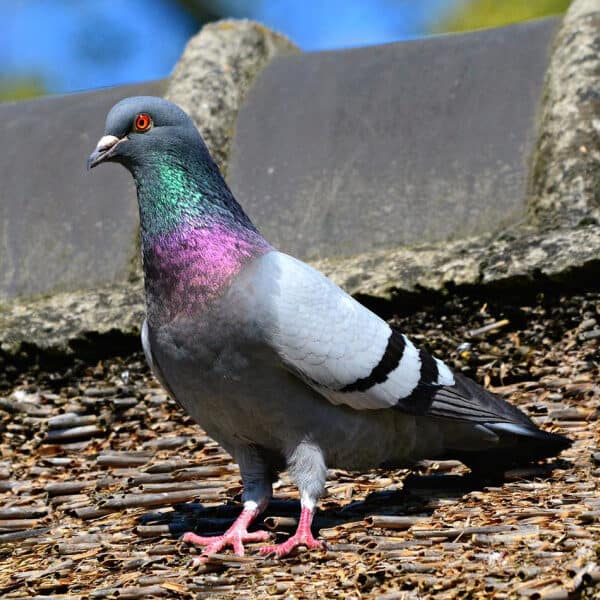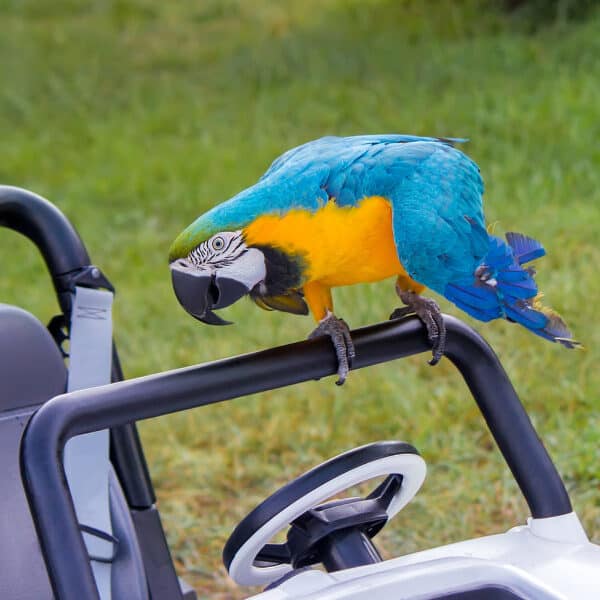Last Updated on by Mitch Rezman
Let’s review the basics. Why do we keep birds in cages? Because if we didn’t, they would fly away.
The weather is getting warm which causes humans to make travel plans. We love our birds, we want them to travel with us. We love our birds, we want them to experience the out-of-doors, something we regretfully deprive them of for the majority of their lives.
Whaaaat?
There are four ways to look at traveling with your bird.
1) You just want to take your bird outside for a few hours or visit somewhere close.
2) It’s time for a getaway weekend and there’s no way you’re going to leave your feathered bundle of joy at home
3) It’s time to cash in those airline reward miles.
4) Road trip!
Oh, you want to take your bird outside in a fabric backpack?
What could possibly go wrong with that?
There’s no way your bird could chew out of something fabric and you would never notice your backpack losing 10 ounces of featherweight, right?
Never underestimate your bird’s desire, ability, and speed to escape from unfamiliar surroundings.
Please use your best judgment when using a fabric carrier, you’ve been warned.
It’s a bird, it’s a plane, no, it’s a bird on a plane.
The rules here are murky. If you plan on traveling with your bird on an airline we suggest you call the airline and get all of the requirements.
Then hang up call back and talk to somebody else to see if they give you the same set of requirements.
When going through security, be prepared to take your bird out of the carrier for inspection.
We can’t promise this will happen but we’ve had customers tell us it’s happened to them.
We have a rigid plastic carrier that will fit under the seat of most airliners.
There are two sides to traveling with your bird. The trip and the destination. Let’s start with the trip.
In that any trip in or on any sort of vehicle whether it be a bicycle, automobile, motorcycle, or motor home your bird has to deal with something called “inertia”.
I like riding very fast motorcycles. On my really really fast motorcycle, I have a backrest so when I accelerate rapidly, I’m not pushed to the back seat which would make driving a bit problematic.
When I break or decelerate, because my hands are on the handlebars I’m able to use my arms to resist catapulting myself forward (and yes I have played the role of human catapult off a motorcycle but that’s another story).
You can take your kid to the Park…
In almost every carrier I see, birds are asked to stand on a bird perch that goes side to side.
So if your bird is in say, an automobile facing forward, every time you accelerate and brake your bird must grab that perch as tight as his muscles allow so he isn’t forced backward (or forward when breaking).
This puts an unusual amount of physical and mental stress on your bird.
For this reason, we recommend installing a U or L-shaped soft rope perch in any travel cage. Think public transportation.
If you’ve ever had the occasion to ride a bus there are grabs and poles along the top portion of the bus that you can hold onto for offsetting inertia.
Booda’s are comfy on a bird’s feet for long periods of time. The bird will sit in the middle of the “U” and the vertical sides allow them to grab a higher point which will help counteract the acceleration and deceleration of the vehicle they are in.
By allowing your bird to sit at the bottom of the “U”, when they sense a change of speed (inertia) they can raise 1 foot and grab the vertical portion of the “U” with the other foot remaining at the bottom thereby helping them offset the inertia.
If you have an SUV or minivan it’s best to secure the travel cage to an area on the floor.
If you have a sedan and the travel cage is going to be placed on a back seat, keeping it in place with the seat belt is a no-brainer.
Knowing to place a spacer between the back of his seat and the carrier so they can’t chew your Corinthian leather, is why you read this newsletter.
Speaking of inertia, make sure that if you have toys in the cage and you’ll be traveling by motor vehicle, the toys are placed so they don’t bang into your birds with every stop and turn.
If your mode of travel is a road trip and you plan on driving past sundown, it’s important to cover the cage before the bright flickering of oncoming vehicle headlights becomes a nervous distraction. Birds don’t like that.
Fast food is a staple of road warriors.
Keeping your bird fed and watered while in motion can be a bit of a challenge.
Counterintuitive as it may be, birds do in fact get car sick. How do you know if your bird will get car sick?
Take him or her for a practice run or two before you learn how such a small body can spew that much birdie vomit just at the moment you’ve reached the point of no return on your road trip.
We’ve read bird car sickness remedies ad nauseam (pun intended).
As far as we’re concerned, you’re on your own with any of the remedies that you find on the web or on Facebook.
We are old-school so we recommend if you find you do have a bird that gets carsick, it’s best not to feed them 6 to 12 hours before prolonged travel allowing them to travel on an empty crop.
Problem solved.
For hydration, place a single large ice cube in the travel cage dish. It keeps water sloshing to a minimum and your bird will enjoy running their tongue across the cold ice.
Whether your destination is a condominium, log cabin, or tent in the woods, It is important that the travel cage has some toys, just like at home, and a cover for nighttime.
Your bird might be a great traveler. We have a customer that travels with four or five macaws in big wire dog crates.
One of the blue and Golds hangs upside down from the roof of his crate for 1400 miles chattering to himself the entire way.
Other birds might not be as comfortable with the ride and/or the destination. When you get to wherever you’re going, it’s important to spend some time with your bird at least in the the same room talking to help reassure him that you – (and the rest of the flock are not abandoning him or her).
So what’s the best type of carrier to use? It’s like determining the right size birdcage. It’s based upon your relationship with your bird. Opaque plastic or even fully clear see-through plastic carriers are fine for use with category 1, short trips with smaller birds. Or by necessary category 2, airline travel.
Birds are about superhuman eyesight (literally) and lung function/capacity. Keeping birds in even partial darkness and without 360-degree ventilation is stressful.
Author Profile
Latest entries
 The Traveling BirdJune 26, 2025Can You Name 5 Parrot Species That Are Living Wild in the USA?
The Traveling BirdJune 26, 2025Can You Name 5 Parrot Species That Are Living Wild in the USA? Bird BehaviorJune 26, 2025How is it Parrots Are Problem Solvers Social Animals and Even Use Tools?
Bird BehaviorJune 26, 2025How is it Parrots Are Problem Solvers Social Animals and Even Use Tools? Bird & Parrot AnatomyJune 25, 2025How a Tiny Chemical Modification Makes Parrots Nature’s Living Paintings
Bird & Parrot AnatomyJune 25, 2025How a Tiny Chemical Modification Makes Parrots Nature’s Living Paintings PigeonsJune 20, 2025How Do Parrots Thrive in Cities Outside Their Native Habitats?
PigeonsJune 20, 2025How Do Parrots Thrive in Cities Outside Their Native Habitats?




